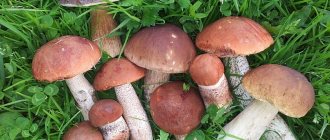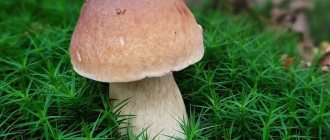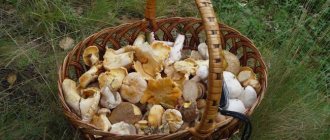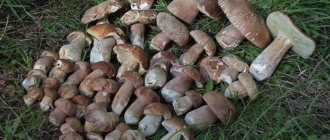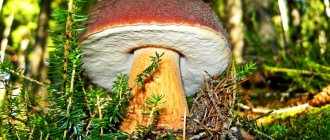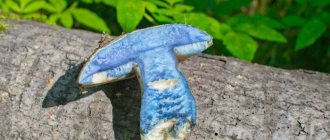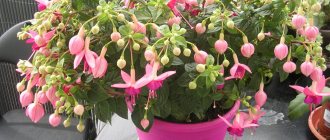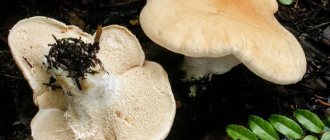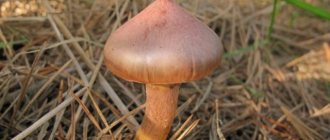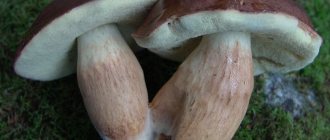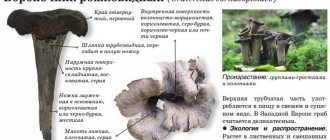5 / 5 ( 1 voice )
Many people like to go to the forest to pick mushrooms. But you need to collect and eat them with caution. If a cut porcini mushroom turns blue or pink, there is no need to risk your health. In this case, the best adviser will be the basic rule of an experienced mushroom picker: “If you’re not sure, throw it away.” But there are exceptions to this rule.
Features of mushroom picking
Poisoning with poisonous mushrooms can lead not only to disorders of the digestive system, but also to severe intoxication of the body with poisons, leading not only to health problems, but even death. Therefore, you should go into the forest for mushrooms armed with a sufficient supply of knowledge about the characteristics of edible mushrooms found in this area, their appearance, places of growth and collection seasons.
Having noticed that the mushroom turns blue when cut, and having certain knowledge, it is easy to determine its nutritional value and effect on the body.
Nature has endowed many organisms with similar characteristics, so the best way to avoid sad consequences is to study the differences between each species and follow the basic rules of collection:
- It is better for a beginner to go into the forest to pick mushrooms accompanied by more experienced comrades;
- collection sites are chosen away from highways, industrial enterprises and environmentally polluted places, because all mushrooms are capable of accumulating toxins from the environment (only in different quantities);
- collect only young, undamaged specimens, avoiding old and overripe ones, which have low taste characteristics;
- if the slightest doubt arises about the suitability of a mushroom for consumption, it is left in place so as not to spoil the entire harvest and not endanger your health.
Types of mushrooms
When examining a mushroom that comes across, pay attention to its size and shape, the color of the fruiting body, the structure of the cap and stem, aroma, color of the plates and pulp at the break. One of the features of these organisms is the ability of the pulp to change color when damaged, which occurs due to the oxidation of certain substances in the air (more precisely, with the participation of atmospheric oxygen).
If the mushroom turns blue when cut, it is carefully examined to determine the species. Both edible and poisonous specimens have this ability.
The opinion that blueness is a sign of the presence of toxins in the fruiting body is erroneous.
Edible varieties
Of the edible popular species, the ability to turn blue on a cut are boletuses, oak mushrooms, Polish mushrooms, as well as a mushroom listed in the Red Book with the strange name “bruise” - blue gyroporus. Their main characteristics are:
- Boletuses: considered valuable and tasty products, they have many varieties. One of them is red or red-headed. The stem of the mushroom turns blue when cut, and after a while becomes black. Outwardly, it is noticeable and bright. The cap of an adult fruit is cushion-shaped, reaching 30 cm in diameter. It has a brick-red color, the surface of the fruit is smooth and velvety in dry weather. Its leg is thick and massive, has a scaly surface. Grows in deciduous forests, at the base of aspen trunks.
- Speckled oakweed: belongs to the Boletaceae family. The cap is large, cushion-shaped, of uneven gray-yellow color. The leg at the base is thick, with a mesh surface. When damaged, the yellowish flesh quickly turns blue-green and then turns black. Found mainly under oak and linden trees.
- Polish porcini mushroom: a valuable and rare representative. It has a convex cap up to 12 cm in diameter, which becomes almost flat in adulthood. Color – from light brown to brown. The leg is straight, slightly thickened at the base. The pulp is dense, with a yellow tint. When damaged, the mushroom first turns blue when cut, then turns brown and has a pleasant mushroom smell.
- Bruise: a bright representative of the Svinushkovy family. It has a wide and almost flat cap measuring from 5 to 15 cm, from white-yellow to brown-gray. Its surface in an adult specimen is slightly cracked. The leg is low, up to 10 cm, cylindrical in shape. When broken, the flesh changes color from white to bright blue.
Irina Selyutina (Biologist):
Hyroporus lividus is occasionally found in Europe and North America. In the post-Soviet space, it can be found in the European part of the former USSR, in the Caucasus and the Far East. Due to its limited distribution throughout Russia, the bruise mushroom is known only to a small number of “quiet hunting” lovers. However, it can be an excellent basis for preparing a wide variety of mushroom dishes. In its dried form, the aroma of gyroporus is enhanced several times (the water leaves, only the dry components of the pulp remain) and the mushroom can be used as a seasoning after grinding into a powder using a coffee grinder or a manual spice grinder.
These edible mushrooms, like a number of others, are mycorrhiza-formers with various types of woody vegetation, giving each other the opportunity for a full existence, because mushrooms supply water and minerals from the soil, and plants “give back” part of the polysaccharides synthesized during photosynthesis.
How to identify a false white mushroom. How to distinguish false porcini mushrooms from true ones?
Popular materials
Today's:
How to identify a false white mushroom. How to distinguish false porcini mushrooms from true ones?
False porcini mushrooms, how to distinguish them from edible ones? After all, these are mushrooms that are very similar to edible porcini mushrooms, but are not. They are found equally often in both small-leaved and coniferous forests, and grow in large clusters adjacent to true whites. This proximity often confuses novice mushroom pickers, who believe that inedible mushrooms grow separately from edible ones and have an unattractive appearance. But, alas, often these misconceptions become the causes of mushroom poisoning.
The gall fungus (species Tylopilus felleus), known as bitterling, prefers sandy and clay soil, coniferous forests, and is most often found on the edges of coniferous forests and illuminated clearings. The gall fungus has a brown or brown, convex, cylindrical cap. The leg is thickened at the base and has a mesh pattern; the tubular layer has a pink color, uncharacteristic for a porcini mushroom. Also, pink color appears on the fracture of the mushroom pulp. But the most important difference is the bitter taste. According to the literature, gall mushrooms are not poisonous, so mushroom pickers have a common practice of tasting porcini mushrooms during collection. However, Western researchers believe that mustard still contains toxins that are quickly absorbed into a person’s blood, settle in his liver and have an adverse effect.
The porcini mushroom turned pink when cooked. Is it possible to get poisoned
All lookalike mushrooms are edible and have the same properties and taste characteristics, which means that there is no reason to worry when discovering similar mushrooms. The boletus family is absolutely impossible to confuse with poisonous mushrooms, so there can be no danger.
Important! Butterflies are often attacked by insects and worms, and if they are not collected in time, the larvae of the worms will leave metabolic products in the tissues of the fungus. It makes no sense to cut out damaged areas, since the mushroom is already completely damaged and dangerous to health, it can cause allergies and intoxication. That is why mushrooms with such damage must be excluded.
Mushrooms that have changed their color during heat treatment do not change the taste of the dish, are quite edible and in terms of processing methods and preparation for the winter are no different from butter mushrooms.
False boletus: signs
Almost every edible mushroom has poisonous counterparts. The boletus is no exception. Beginning mushroom pickers are often interested in what signs a false boletus mushroom can show.
First, carefully examine the find: because of the terrible bitterness, even insects and worms do not eat the false boletus. Therefore, if the mushroom does not have the slightest speck, this should alert you.
The false boletus, a photo of which you can see in our article, has a cap with a velvety surface, while the real boletus has an absolutely smooth surface. Although the place where the mushroom grows can change its appearance, color and texture - they can become dry and smooth, a little velvety or moist, even in hot and dry weather. The wet caps of mature false mushrooms lose their shape when touched.
A real boletus has a thin stem or slightly thickened towards the bottom. Its cap is no more than 18 cm in diameter. The false mushroom is most often massive and does not have veins in the form of tubes. At a more mature age, it develops a tuberous stem, then the cap straightens and takes on the shape of a saucer.
The gall fungus often grows in places unusual for boletus mushrooms: in oak groves or deciduous forests, near rotten stumps and in ditches.
In real boletus, spots are clearly visible on the leg, reminiscent of the pattern on the trunk of a birch tree. If it is missing, discard your find. On the stem of the false boletus you can see veins that resemble thin blood vessels.
False boletus has a red-greenish or bright brown cap. If you find a green color on it, eating such a mushroom is strictly prohibited. Edible boletus cannot have such flowers. Pay attention to the bottom of the cap. In the gall mushroom it is pinkish, while in the edible mushroom it is pure white.
A lamellar mushroom similar to white. K. G. Bulgakov
Family Ramariaceae – Ramariaceae
Eating
Mushrooms are a healthy and nutritious natural product. They contain a large amount of vitamins, microelements and essential amino acids. Being a low-calorie product, mushrooms are used in dietary and vegetarian nutrition. And their high protein content has made them popular in special sports diets. In addition, the beneficial substances and compounds contained in mushrooms are successfully used in folk and traditional medicine.
Fruit bodies that change the color of the flesh to blue are not always unsuitable and dangerous for consumption.
Is turning blue a warning sign, or a trifle not worth attention?
The pulp can turn blue in a matter of minutes in ordinary boletus mushrooms and in the satanic mushroom, so this feature cannot be decisive in answering the question of whether it can be eaten. Some people mistakenly believe that the blue color is a characteristic sign of the presence of toxins, we repeat that this is a misconception. Why do mushrooms change color to blue? It turns out that the reason is that the pulp, when exposed to air, oxidizes and its tissues turn blue. This happens even with very tasty and healthy mushrooms.
Blue milk mushroom
This mushroom is distributed throughout our country, but prefers to grow in the forests of Siberia and the Urals. Many residents of foreign countries consider it inedible, but this is not so. It’s just that the cooking technology causes a lot of trouble. This mushroom has many names: purple, blue, lilac, dog.
Many edible mushrooms turn blue when cut. A typical representative is the blue milk mushroom. Its cap reaches a diameter of fifteen centimeters and is yellow in color. If you cut or press on a mushroom, it turns blue. Hence the name. The cap of young milk mushrooms is slightly convex, but as they grow and age, it becomes spread out or depressed. Blue milk mushrooms are mushrooms that turn blue when cut. The photo clearly demonstrates this. The mushroom is distinguished by dense and thick pulp, which can be yellow, light brown or cream in color. When interacting with air, the white juice turns purple.
This mushroom has no doubles. Mid-August - early September is the best time to collect blue mushrooms, which are rich in mixed and coniferous forests. They hide under birch and spruce trees. These milk mushrooms are fried or boiled. They are not pickled, as both the mushrooms and the liquid turn blue.
Useful properties of bruises and preparation features
The bruise mushroom is very easy to recognize from just a photo or description, but it is not so easy to find in the forest due to a decrease in its population in recent decades. Other names for the mushroom - blue gyroporus, birch gyroporus - are used much less frequently, since the main distinguishing feature prevails over the others.
The cap of a felt-type mushroom changes from convex to flat as it grows; it can have shades of whitish, brown and yellow, but with simple pressure it quickly turns blue at the point of contact. The tubular section has few pores, usually white or straw color, and the spores are yellow. The leg is loose and hollow, without a ring.
The cap of the bruise can reach 15 cm, the leg is cylindrical, up to 8 cm high, and has an extension at the bottom. The pulp is whitish-cream, brittle. The taste and smell are pleasant. When cut or broken, the fruit body turns a characteristic cornflower blue color.
You may be interested in:
Oak forests, coniferous forests, warm sandstones heated by the sun, humidity and a warm climate are the main preferences of these mushrooms. It grows better under birch, pine, chestnut and oak trees, since gyropores form a symbiotic association with the roots of these trees - the exchange of nutrients.
In Russia, these mushrooms are most often found in deciduous and mixed forests of Western Siberia. In Europe and Central Asia, the fungus is more common in the steppe zone.
Since the mushroom is rare, many people wonder whether it is edible or not. It is classified into the second or third category of edibility according to different classifications. But according to experienced mushroom pickers, it is edible, tasty and nutritious, although it is suitable for consumption only after heat treatment.
Mushroom in section
Individual intolerance to the fungus is possible due to disorders of the gastrointestinal tract and chronic diseases of the liver and kidneys.
Gyropores cannot be confused with dangerous poisonous mushrooms due to their individual characteristic of turning blue.
But due to inexperience, one can easily mistake the chestnut gyroporus for a bruise, which looks very similar to them, but at the first cut of any part of the chestnut twin, the mistake immediately becomes obvious, its fruiting body never turns blue.
Yunkville Boletus
You can also mistake the conditionally edible Yunkville boletus for a bruise; its flesh at the site of the break turns blue, but very soon the blueness turns black.
Bruises require restoration, without which they can disappear as a species, so they need to be collected very carefully, trying not to damage the mycelium. It is better to cut off only part of the stem, not to take old and damaged mushrooms, leaving them for further propagation.
A mushroom of the third category of edibility, which is pleasant to the taste, does not have bitterness, does not appear harsh during cooking, has an inherent strong aroma, contains many useful substances, including the natural antibiotic boletol with a wide range of action and minimal side effects .
Antioxidants in the fruiting body of the bruise are used in the prevention of various types of tumors. Potassium, magnesium and sodium in well-absorbed forms help improve the functioning of the cardiovascular system and increase the human body's defenses.
But bruises also contain poorly digestible compounds, so people with impaired stomach, liver and kidney function, as well as pregnant women and children, are not recommended to use them.
Interesting!
The young specimen is distinguished by the fact that it does not have a pungent odor or bitterness; its taste has notes of nuts.
It can be stored raw for up to two days, and boiled for 2-3 days in liquid. It is suitable in boiled and dried form, and is used to prepare soups, sauces and stews. You can fry and stew with or without vegetables.
The soup made from bruises with raisins and prunes is piquant, original in taste and nutritious. To prepare it, it is better to use dried ingredients, to which potatoes, onions, a little wheat flour and vegetable oil for frying, parsley and salt are added. In this case, the mushrooms are boiled first separately and the resulting broth must be drained.
Fried mushroom bruise
Bruises fried with nuts are very tasty. For 0.5 kg of fresh bruises, take a glass of peeled walnuts, onions, cilantro, apple cider vinegar, ground pepper, butter and salt.
Mushroom - bruise
It got its name for a special property: when cut, its flesh changes color from white to bright blue. If the mushroom looks like a white mushroom and turns blue when cut, this is a bruise. The appearance of these two varieties is very difficult to distinguish. The bruise mushroom is extremely rare, so information about it can be found in the Red Book.
The diameter of its cap reaches 15 cm. In a young mushroom it is convex, and in an adult it is spread out. You can see subtle cracks on the brown or yellowish cap. Mushrooms turn blue when cut when touched and pressed. Therefore, they cannot be confused with poisonous mushrooms, which lack this ability. Under the cap there are yellow spores and tubes that instantly turn blue at the slightest impact on them. The leg is dense, tuberous in shape. Its structure is gradually being destroyed. In an aging mushroom it is hollow.
The pulp does not have a special taste or smell. This species is good when stewed. The bruise mushroom is a fan of humid, warm climates; it can be found in oak and coniferous forests from mid-summer until its end. What mushroom turns blue when cut? This may be a relative of the bruise - the chestnut mushroom, which is also rare and also found a place in the Red Book.
Purple mushroom on a cut.
There are many mushrooms that turn blue when cut. Let's try to figure it out and determine which mushroom you are interested in:
Speckled Oak (Boletus erythropus) is a mushroom from the Boletus genus. The cap is up to 20 cm, has a hemispherical, pillow-shaped, rounded pillow-shaped shape, velvety, matte, occasionally mucous, can become bare with age, color is chestnut-brown, dark brown, dark brown, black-brown, may have olive or reddish tint, darkens or turns black when pressed. The pulp is yellowish or bright yellow, quickly turns blue or greenish-blue when cut, in the stem it is reddish or brownish, without taste or smell. Leg up to 15 cm, cylindrical or tuberous, barrel-shaped, later usually thickened at the bottom, yellow-red color, without a reticulate pattern, but with red scales or dots. The tubes are yellow, later yellow-olive, olive, greenish-yellow, the pores are rounded, small, yellow, later orange, brick-red, turning blue when pressed.
Polish mushroom - a cap with a diameter of up to 12 cm, convex, later straightens out and becomes flat, usually dark brown in color, oily, but depending on the weather it can be glossy or dry. Mushrooms growing in deciduous forests usually have a dry, velvety cap. The tubes are initially faded, dirty yellow, later they acquire an olive tint; in freshly cut mushrooms the tubes turn blue when pressed. Spore powder is olive brown. The leg is usually cylindrical in shape, up to 8 cm. There are also specimens with a short thick leg of brown color with a yellowish pattern, “marbled”, smooth, without a mesh or veins. The flesh is pale, whitish-yellow, the flesh of the cap turns slightly blue when cut. The smell is weak.
Dubovik is olive-brown - the cap is up to 20 cm, cushion-shaped, yellowish-brown, beige, velvety, dry, in old ones it is smooth, bare. The leg is up to 15 cm, yellow-orange, with a clearly visible dark red mesh. The pulp is light yellow, turns blue when cut. The surface of all parts of the mushroom turns blue when pressed. A good, edible mushroom that requires preliminary boiling. The stem is tuberous with a mesh pattern, scaly or smooth.
The reddish boletus has a convex bright red cap. The leg may be thickened towards the base. Light yellow flesh slowly turning blue.
Satanic mushroom is fleshy with a hemispherical, smooth, light, almost white cap. The mushroom is easily identified by the orange to blood-red color of the pores and the yellow or blood-red mesh, which is the same color throughout the entire stem. The pulp is yellow or white. The pores of the fungus turn blue when damaged.
Frost's boletus - cap up to 15 cm, hemispherical, later convex. The boletus pulp is up to 2.5 cm thick, lemon-yellow, immediately turning blue when cut. The tubular layer is yellow. Leg 4-12 x 1-2.5 cm, thickened at the base, red, yellowish at the base. Frost's boletus spores are olive-brown.
The bolet is yellow-pink - the cap is up to 14 cm, brown, ocher, bronze, the stem tapers towards the base. The flesh is light yellow and sometimes turns blue when cut. Similar to Polish.
Boletus - when cut, the flesh first turns blue, then becomes blue-black.
Bruise - cap up to 15 cm, grayish-brown, turns blue when touched. When cut, the flesh turns blue instantly.
The moss mushroom is yellow-brown - the flesh turns green-blue when cut.
Moss fly is fissured - the flesh turns blue when cut, then turns red.
Boletus
These mushrooms have several varieties, one of which is the red boletus. It is also called redhead, aspen, and redhead. This is exactly the species they are talking about: the mushroom stem turns blue when cut. The boletus has a luxurious cap, the diameter of which can reach thirty centimeters. In young mushrooms it is hemispherical in shape with the edges tightly attached to the stem. Mature mushrooms are distinguished by a cushion-shaped cap, which is easily separated from the stem. The skin is red or terracotta, hence the name. The surface is velvety, smooth. The tubes under the cap are white with a yellowish or olive tint.
An adult mushroom is endowed with a high, thick stalk. It is covered with small scales, the grayish-white color of which changes to dark in adult mushrooms. The cap is elastic and fleshy. Over time, the leg acquires a fibrous structure. At the break it first turns blue and then turns black. The smell of the mushroom is weak, but has a pleasant aroma.
Podduboviki
These mushrooms have another name - Polish. They are among the rarest blue specimens. They are found only in oak or deciduous forests. Podburoviki differ in that their flesh instantly turns blue when cut or even turns purple. But as soon as they are dried, the pigment disappears. Boletus mushrooms are easily confused with aspen mushrooms or porcini mushrooms. To prevent this from happening, just look closely and you will see that the Polish mushroom always grows with an open cap.
The pulp of the fruit is very pleasant to the taste, which is often the reason for damage by worms. The skin of a coffee or chestnut cap shines, but does not stick to your hands. The layer of tubes has a yellow or greenish color. These mushrooms turn blue when cut. But there is no need to throw them away. If you are not sure whether a mushroom is edible or not, put it in another basket, and at home you will find information that will tell you what to do.
boletus
Product Description
Boletus is a common Russian name for several species of mushrooms from the genus Leccinum or Obabok (Leccinum). The habitat of the boletus is deciduous forest. The boletus grows mainly in birch forests and mixed forests, in damp, wetlands under birch trees, as well as in gardens where there are birch trees.
Boletus mushrooms have a somewhat slippery, dull, brownish cap color. The cut flesh is not always colored. Other signs are brown scales on the stalk and whitish tubes. From boletus mushrooms (which are also several species of mushrooms from the genus Leccinum), boletus mushrooms differ not only in the color of the cap, but also in the thinner stem and less dense flesh of the cap.
Popular boletus mushrooms are called differently: babka , white and black babka, birch mushroom , gray mushroom , black mushroom , obabok , brant .
Types and varieties
All boletus mushrooms are edible . Botanists distinguish several species of boletus (and they argue which of them is really a species and which is a subspecies of one of the species):
- common boletus (Leccinum scabrum) - the same classic boletus with a brown, slightly slippery cap;
- black boletus (Leccinum scabrum f. melaneum, Leccinum scabrum melaneum), which has a darker cap, in some cases almost black;
- marsh boletus , also known as white boletus (Leccinum scabrum f. chioneum, Leccinum holopus) - so named because it grows more often in swamps, and its cap is very light, white or whitish-brown;
- pink boletus , also known as oxidizing boletus (Leccinum scabrum f. oxydabile, Leccinum oxydabile) - so named because when cut it acquires a coral tint in the cap and yellowish-gray in the stem, while many other types of boletus (for example, common) color do not change on the cut;
- gray boletus , also known as hornbeam (Leccinum carpini, Leccinum pseudoscabrum) - known in the Caucasus and loves the company of the hornbeam (a relative of the birch), the color of its cap can be either light gray or brown; when cut, the flesh turns pinkish-violet. , then to gray, to almost black;
- boletus is harsh , it is also hard and poplar (Leccinum duriusculum) - its flesh is really a little harder than that of other species, and at the break it turns red (in the cap and the upper part of the stem) or turns blue (in the lower part);
- checkerboard boletus , or blackening boletus (Leccinum nigrescens), the cap of which is brown-yellow, and the flesh when cut becomes wine-red or violet-brown, and then turns black; known in warm regions of Europe, in Russia - in the Caucasus;
- ash-gray boletus (Leccinum leucophaeum), the name of which alludes to the color of the tubular layer - the lower part of the cap, while the skin of the cap is brown, and the flesh turns pink when cut (blue at the base);
- boletus variegated , also multi-colored (Leccinum variicolor), which is quite different from other boletus in appearance: its cap is very dark, almost black, variegated, with yellowish tan marks of an oblong shape (although there are several varieties of boletus variicolored with a brick or orange cap color, also variegated), the leg at the base is blue-green, acquiring a pinkish and greenish tint when cut; These mushrooms grow under birch, poplar, oak and spruce trees.
In culinary and taste terms, different types of boletus (as well as boletus) are almost no different from each other.
How to cook
The flesh of boletus mushrooms becomes loose very quickly, so it is better to take young boletus mushrooms and cook them together with other mushrooms, since they themselves do not have a distinct taste. The boletus darkens with any treatment.
Boletus mushrooms can be fried and stewed (they go especially well with sour cream), you can marinate and salt them, they make a good mushroom soup. You can make pasta and risotto with boletus mushrooms.
In various dishes, boletus mushrooms go well with buckwheat, pearl barley, rice, potatoes, cabbage, carrots, lentils, peas, and sweet peppers.
Boletus mushrooms are great for filling pies, pizzas, rolls, and homemade bread. It is advisable to prepare the mushroom filling in advance, that is, lightly boil or fry the mushrooms before placing them in the dough.
Season
In central Russia, boletus mushrooms are harvested from June to October, but the main season begins from late July to early August. In some areas they can be found until November.
How to select and store
Boletus mushrooms do not hide in the grass, they are always in sight, they are easy to collect in spacious birch forests in groups and individually. Boletus mushrooms can be found at the edge of the forest, on the lawns of birch and mixed forests. In a mixed forest, the boletus stays closer to the birch.
You should not pick mushrooms near the road: they absorb harmful substances from the exhaust gases of passing cars. The safe collection zone begins several hundred meters from the highways.
The only mushroom with which an inexperienced mushroom picker can confuse boletus is the gall mushroom or, in common parlance, false boletus (Tylopilus felleus). It looks like an ordinary one - its cap is tubular on the bottom, brown on the outside, and its leg is pockmarked. It is not poisonous, but if you come across one such mushroom, the whole dish will be spoiled, because it is very bitter, and this bitterness intensifies when cooked. The first sign of false boletus is a pinkish tint to the tubular part of the cap. In doubtful cases, you can touch it with your tongue (the sensation is so-so, but it is not dangerous). To accurately determine the type of a particular mushroom and whether it belongs to edible or poisonous mushrooms, you should consult special reference books.
When purchasing boletus mushrooms, it is advisable to find out where they were collected. It is better to purchase mushrooms at stationary markets, where products are checked for compliance with sanitary standards.
Avoid buying large mushrooms . All for the same reason - the older the mushroom, the higher the concentration of absorbed toxic substances. And, as a rule, there are fewer worms in young boletus mushrooms.
Do not buy already processed mushrooms “from hand”: dried, salted, pickled, etc. Among other pieces, you may also find pale toadstools, it is better not to risk it.
Mushrooms are perishable foods and cannot be stored for a long time. Boletus mushrooms must be processed on the day of collection (or on the day of purchase).
First of all, the mushrooms are cleared of debris, the stems are cut off, and damaged areas are cut out. To prevent the mushrooms from turning black, use stainless steel knives. Then they are either cooked immediately or stored for future use.
The main ways to preserve mushrooms are drying , freezing , salting , pickling (and canning in sterilized, hermetically sealed glass jars). Dried mushrooms can be used to make mushroom powder . You can also prepare (and then preserve) mushroom extract .
Does the porcini mushroom turn blue when cut or not?
This mushroom is often confused with the satanic mushroom - a double of the porcini mushroom. But the difference is that in a poisonous representative of this species, the fracture first turns pink and then turns blue. The white edible mushroom does not change color when cut, remember this! What mushroom turns blue when cut? Satanic, which has a cap similar in color to a porcini mushroom, but the spores underneath are red or orange. Its leg is bright yellow with a red mesh pattern.
The shape of the cap of all poisonous mushrooms is slightly dome-shaped, while in white mushrooms it is spherical with a whitish edge in young mushrooms. As they mature, they have a convex cap of brownish-red or brown color. The tubes under the cap are initially white, but later acquire a yellow or green tint. The leg is light, barrel-shaped with a netted brown pattern. Do porcini mushrooms turn blue when cut? The answer is clear: the color on the cut of this mushroom never changes!
Poisonous doubles of porcini mushroom
In the forest you can also find false, poisonous specimens, for example, bitterweed and satanic bolete.
Gorchak is distinguished by its external characteristics:
- a thick leg, like a real white one, but has a pronounced mesh texture;
- the flesh is light pink or dirty white;
- bitter taste, which only intensifies during heat treatment.
Important: under no circumstances should you taste the mushroom (touch it with your tongue or lips) to determine its edibility. For example, toxins contained in mustard pulp can cause liver disease.
The satanic bolet is similar to the white oak tree in the shape of the stem and cap. But the color is strikingly different:
- the stem is bright red or burgundy, and the inside of the cap is red or bright orange. Turns blue when broken, very poisonous;
- When it is cut, it emits an unpleasant odor.
Important: Satan's bolete is toxic; eating it can cause paralysis of the nervous system.
There are two more lookalikes that are conditionally edible, but their flesh is very bitter - these are the gall mushroom and the rooting boletus. The gallbladder has a pinkish hymenophore, and the rooting boletus has a blue and white cap. When cut or peeled, the flesh turns blue.
Beneficial features
- Mushrooms contain large amounts of vitamin D, just like butter.
- In terms of vitamin B content, they are not inferior to cereals.
- Mushroom lecithin reduces cholesterol in the blood, which makes them useful for people with impaired metabolism, vascular and heart diseases.
- It is recommended to include mushrooms in the diet menu, as they are low in fatty acids, which prevent arteriosclerosis.
- They are used as an anti-cancer and stimulating agent for the human body.
- Mushroom enzymes break down fats, so they should be consumed by people who want to lose weight.
- It contains fiber in large quantities, which cleanses the stomach and improves digestion.
Harmful properties
- Mushrooms contain a lot of plant fibers and chitin, which are difficult to digest, making beneficial substances poorly absorbed. To eliminate this, the mushrooms are dried, thoroughly ground and stored in hermetically sealed jars in a dark place. Important: table salt is added to the mushroom powder. This drug is used as a seasoning.
- There are many toxic and radioactive substances in the atmosphere that are absorbed by edible mushrooms. Therefore, collecting them along roads and in areas with industrial enterprises is fraught with danger to life. You should not buy mushrooms at the market, since it is not known where they were collected. Possibly in an environmentally polluted area.
- Don't go mushroom hunting alone. Remember, if a poisonous mushroom gets into the basket, this can lead to poisoning of all its relatives. Better get rid of the contents of the basket.
- Mushrooms are considered heavy food, so they should not be consumed by babies, nursing and pregnant women, and people with various diseases of the digestive tract.
Mushroom season is called quiet hunting. Be careful not to let this silence make you worry. Collect only edible mushrooms!
Note for beginners
- Mushrooms have one peculiarity - they accumulate heavy metals, toxins and other elements that are dangerous to human health and contain atmospheric air and soil. Therefore, it is prohibited to eat mushrooms collected near major highways, near cities and industrial enterprises. Do not buy mushrooms at spontaneous markets, which is called “from hand”.
- Be careful what you put in the basket. A poisonous mushroom may not have the best effect on those it lies next to, so is it worth bringing such a dangerous “trophy” from the forest? And if you doubt whether a mushroom is edible or not, never take it. Having brought it home, in the chaos you can forget about your doubts, and the dubious product ends up in your frying pan.
- If you are a novice mushroom picker and it is still difficult for you to recognize mushrooms, do not hesitate to take with you on a “quiet hunt” photographs of mushrooms growing in your area. This way you can protect yourself from a fatal mistake and quickly remember what mushrooms look like.
Remember, you should not risk the health of yourself and your loved ones because of the temptation to taste a delicious delicacy.
Mushrooms with blue stems
The porcini mushroom is deservedly considered the king of the mushroom kingdom, but besides it, there are many other, outwardly similar varieties in nature. For mushroom pickers, it is useful to combine them all into two groups: edible and inedible, and often both options are characterized by similar features, such as a blue stem or other parts of the fruiting body.
The reason for this phenomenon is the oxidation of tissues under the influence of air, and this is not necessarily an alarming signal - often such changes are characteristic of tasty and quite healthy mushrooms, for example, bruise or milk mushroom.
Edible
The most popular edible mushrooms among those under consideration can be considered boletus, boletus and Pansky mushrooms (also known as Polish mushrooms).
Like real white, all these options are characterized by good taste characteristics, especially if you pay due attention to their culinary preparation. Of course, each of them also has its own unique features that help set it apart from other relatives.
Boletus
Boletus is a strong and dense mushroom, with a white stem and a round red cap . When mechanically damaged, its tissues turn blue, and after some time they acquire an attractive cornflower blue color, although they can gradually turn black if left for a long time.
Why does the porcini mushroom turn blue?
Inexperienced mushroom pickers mistakenly believe that if a false porcini mushroom turns blue when cut, this indicates the presence of toxins in its pulp. Changes in color only indicate that its fibers have come into contact with oxygen and an oxidation reaction has begun. This process does not affect the taste of the fruiting body in any way.
Sometimes the flesh turns bluish within 10-15 minutes, however, in some varieties the fibers change color in a matter of seconds. Usually blueness affects any part of the fruiting body, but there are also false porcini mushrooms that turn blue only under the cap.
Advice! It is better to check the find for color changes directly in the forest, and not at home. In this case, after making the cut, the knife must be thoroughly washed and disinfected so as not to accidentally cause poisoning if the double is poisonous.
